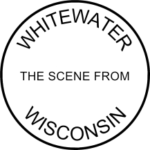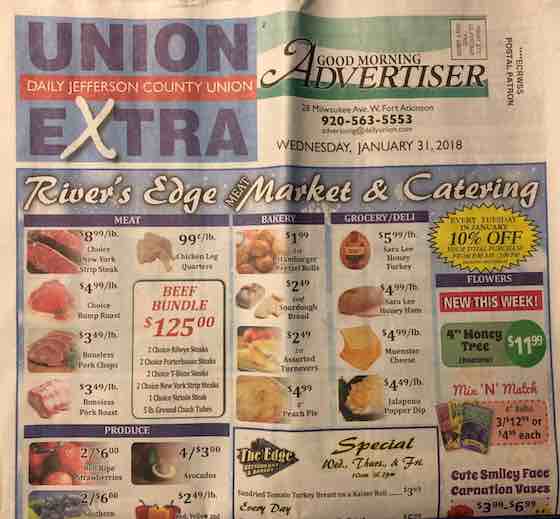So, if one lives in Whitewater, he or she may find a shopper-advertiser in the mailbox, with ads from (mostly) out-of-city advertisers. Even if one omits the publisher’s own ads, and public service announcements, the ratio of out-of-city to Whitewater ads is something like 3 to 1. Indeed, the largest ad, on the front page, is for a meat market in Jefferson, WI, and every other front-page ad is also for an out-of-city merchant.
Fundamentally, for this print publication, most of the ads come from out-of-city businesses.
What does this mean?
1. It means that these advertisers believe that there’s value in letting potential Whitewater customers know about their Fort Atkinson, Jefferson, Palmyra, and Milton businesses. They must believe – rightly or wrongly – that the ads bring returns that justify their cost.
2. These are print ads, and for the items advertised, the delivery to homeowners’ mailboxes, and the general nature of print readers (older), this is an audience of the middle-aged.
3. There are Whitewater businesses competitive with these out-of-city merchants, but (a) many people in Whitewater would already know about those Whitewater businesses, and (b) city merchants have an option of digital ads on the Whitewater Banner. (That’s an interesting question for businesses already familiar to Whitewater’s residents: shouldn’t every ad in print or online be a specific call to action?)
4. Out-of-city merchants have, both proportionately and absolutely, larger numbers of consumers aged 25-65 than Whitewater does. See Data Around Whitewater’s Size and Whitewater, Cultures & Communications, June 2017 (Part 5: Working Age). They have a larger, middle-aged consumer market in their own cities. For the cost of a print ad, they may think they can attract a few extra customers to their comparatively advantaged businesses. It’s incremental gain, not a customer base, they’re seeking.
5. Old Whitewater has two solutions for the relatively smaller numbers in the 25-65 age bracket. First, to restrict rental opportunities for the majority of the city’s population – a majority that expresses a desire for more rental options. The first option foils free choice to advance the plans of an aging, middle-aged minority faction within the city.
Second, to try to develop additional single-family homes in Whitewater. On a scale to compete with the larger, existing single-family home markets in Fort Atkinson, Milton, Jefferson, etc. would require several hundred, if not over a thousand, additional homes. That’s not a big task – it’s a wildly improbable one.
6. Merchants and city officials should acknowledge and support this city’s majority demographic, rather than pretending it’s not this city’s majority demographic. Whitewater should be a place for all people, but that’s not possible when a few aged men and women – a minority within a minority – deny or thwart the city’s actual majority.
To love a place requires more than a controlling desire. A few striving planners and their minority faction want to change the free choices of thousands of buyers and sellers in this beautiful city, and in cities nearby.
The direction of this city – as expressed through the wishes of thousands in the marketplace each day – will confound both the efforts of those who want to restrict and those who want to subsidize against this direction.


